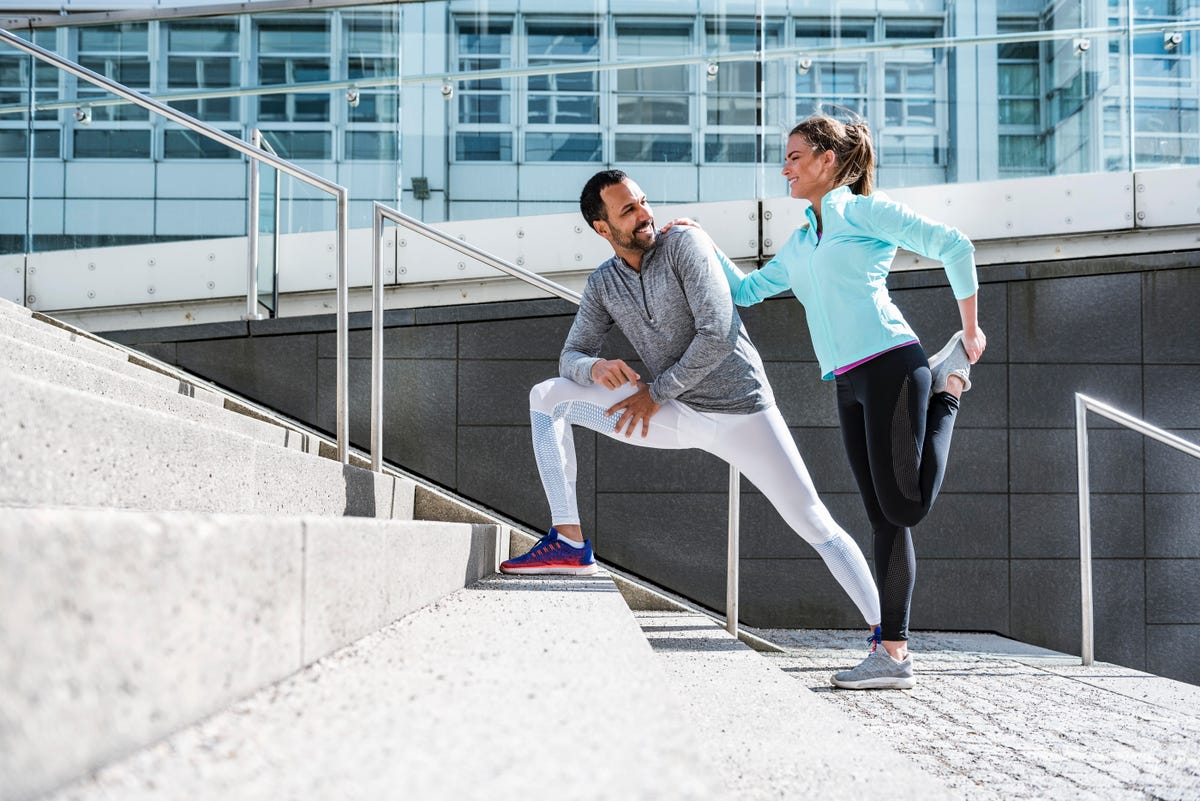Should You Continue With Active and Static Stretching
Working out consistently is hard enough -- and with all of the disagreements about how to structure your routine, it's easier to forget it all together. One part of exercise I've consistently seen disagreements on is stretching. Some people are vehemently opposed to the idea, saying that the practice is bunk and a waste of time. Others swear by it, believing that stretching is vitally important and helps ward off all kinds of injuries.
Stretching is not actually as simple as it sounds. There are several different types of stretching, and each one is beneficial during a distinct point of your workout routine.

Stretching isn't just for your legs -- if you use a computer all day, loosening achy wrists feels great.
Getty ImagesI'm here to dispel the confusion once and for all and explain how exactly stretching should fit into your exercise habits so that you can finally get back to what's really important -- actually working out.
Read more: Peloton Bike vs. Peloton Tread: Which should you buy?
Why should you stretch at all?
In general, stretching is a great practice to incorporate into your daily routine, even if you don't exercise often. Stretching keeps your muscles flexible and able to perform their entire range of motion. If you aren't flexible enough, your muscles won't extend to their full length, and you face a greater likelihood of muscle strain, joint pain and injury.
But, it turns out "stretching" isn't as simple as it sounds. There's static stretching, dynamic stretching, passive stretching and more, and different types are better suited for separate times of your workout.
Static stretching is probably what you're most used to. It involves striking a pose and standing still for 30 seconds, like the classic touching your toes or holding one arm across your chest to stretch the shoulder. On the other hand, dynamic stretching involves running a muscle through its range of motion 10-20 times, like swinging a leg back and forth or rotating your trunk to warm up the back. The other types of stretching can be beneficial, but aren't as common.

Stretching puts you in a good mood, so it's a fun activity to do with friends.
Getty ImagesShould you stretch before your workout?
No matter what your middle-school gym teacher said, you actually shouldn't perform static stretching before you exercise, especially if your workout involves the lower body. The muscles aren't warmed up yet, and performing static stretching while you're still cold won't do anything in terms of injury prevention.
A comprehensive review found that static stretching, when done alone before working out, led to decreases in strength, power and explosive performance. So static stretching won't stop injuries from happening, and it'll also lead to bad workouts.
Instead, what you can do for 10 to 15 minutes before working out is an active warmup. (Think jumping jacks, a brisk walk or jogging in place.) This easy activity will get your heart pumping and your muscles warm, and then you'll be ready for strenuous activity.
Read more:The best treadmills of 2019: NordicTrack, Nautilus, Peloton and more

Jumping rope is a great way to quickly warm up for your workout.
Getty ImagesYour active warmup should include dynamic stretching, so you'll technically be performing some stretches, but not in the way you might be used to. Dynamic stretching improves range of motion and decreases injuries by getting your muscles properly prepared for the exercise and helping them achieve full functionality. Many strains happen when the muscle is forced into a movement it's not ready for, so an active warmup with dynamic stretching will mitigate this risk.
For example, leg swings and walking lunges are great dynamic stretches to do before running and other cardio, and arm circles can be useful for before lifting upper-body weights.
Should you stretch after your workout?

Help keep your workout buddy accountable to stretching after you're done.
Getty ImagesIf you love the more static stretches like the classic touching your toes, the good news is that you don't have to give them up. Static stretching is beneficial to do after your workout to help you recover and get ready for the next one.
While stretching probably won't make you less sore the next day -- by this point, the microscopic damage that causes sore muscles has already happened -- research suggests that it helps improve blood flow to the limbs you stretch. The blood delivers nutrients and oxygen to the affected muscles, helping aid in recovery and rejuvenation. It's also associated with helping your nervous system calm down, which isn't surprising to anyone who's practiced gentle yoga. This relaxing effect will help slow your heart rate down, and one study showed that over time static stretching decreases heart rate variability (how fast your heartbeat returns to normal after exercise).
Although all this warming up and cooling down may seem like a waste of time, properly easing into and out of your strenuous activity is vitally important for warding off injury and decreasing stress on your heart and other organs. So, if you're really crunched for time you might want to consider shortening the actual workout. Your health and wellbeing will thank you in the long run.
Read more: Heart-rate tracking is the secret to getting fit

Watch this: Ring Fit Adventure is a real workout
The information contained in this article is for educational and informational purposes only and is not intended as health or medical advice. Always consult a physician or other qualified health provider regarding any questions you may have about a medical condition or health objectives.
Source: https://www.cnet.com/health/fitness/stretch-before-or-after-a-work-which-is-best/
0 Response to "Should You Continue With Active and Static Stretching"
Post a Comment